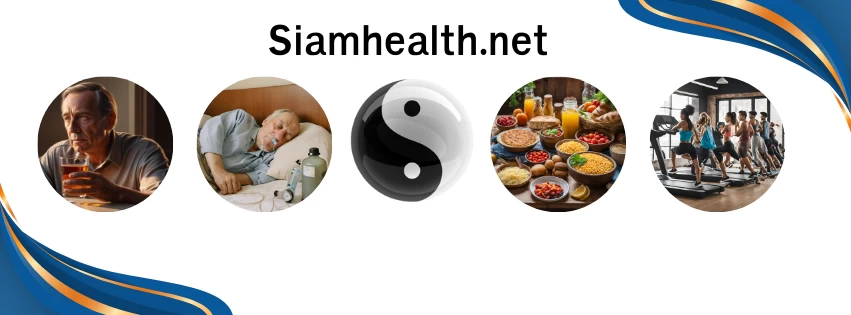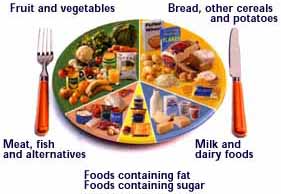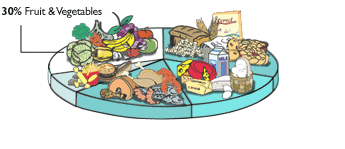
หน้าหลัก | สุขภาพดี | สุภาพสตรี | การแปลผลเลือด | โรคต่างๆ | ยารักษาโรค |วัคซีน | อาหารเพื่อสุขภาพ
อาหารเพื่อสุขภาพ
อาหารเพื่อสุขภาพประกอบด้วยอาหารห้าหมู่ อาหารหลักได้แก่หมวดแป้ง โดยเพิ่มการรับประทานผักและผลไม้ ทานอาหารโปรตีนจำพวกเนื้อสัตว์ ปลา ดื่มนมหรือผลิตภัณฑ์ของนม ลดอาหารมัน ลดอาหารเค็ม ลดน้ำตาล เพียงแค่นี้คุณก็จะได้อาหารสุขภาพ หลักสำคัญต้องรับประทานอาหารหลากหลาย ในอัตราส่วนที่เหมาะสมเพื่อให้น้ำหนักอยู่ในเกณฑ์ปรกติ
รับประทานอาหารให้ครบ 5 หมู่
อาหารที่เรารับประทานแบ่งเป็นกี่ประเภท

ในการเลือกรับประทานอาหารเราจะเลือกกลุ่มหนึ่งถึงสี่เป็นส่วนใหญ่ ส่วนกลุ่ม 5 ให้รับประทานนานๆครั้ง
คำแนะนำอาหารสำหรับเด็ก
กลุ่มอาหาร
กลุ่มผักและผลไม้
ธัญพืชครบส่วน Whole grain
ธัญพืชครบส่วนเป็นแหล่งที่ให้ใยอาหารและสารอาหาร ปกติเมล็ดพืช จะมีส่วนประกอบที่สำคัญคือ เปลือก รำ ส่วนแพร่พันธ์ และอาหารสำหรับเลี้ยงส่วนแพร่พันธ์ เมื่อเรากระเทาะเอาเปลือกออกก็จะเหลือธัญพืชครบส่วน(ซึ่งประกอบด้วย รำ ส่วนแพร่พันธ์ และอาหาร) หากเรานำไปขัดก็จะสูญเสียสารอาหารที่สำคัญ vitamins, minerals, lignans, phytoestrogens, phenolic compounds, and phytic acid. ธัญพืชที่ผ่านการขัดบางชนิดจะมีการเติมวิตามินบางชนิดก่อนขาย แนะนำว่าควรจะรับอาหารธัญพืขครบส่วนอย่างน้อยวันละ 3 ออนซ์ ตัวอย่างสำหรับแป้งที่ทำจากธัญพืช
ตารางแสดงธัญพืชครบส่วนที่ไม่ผ่านการขัดและที่ผ่านการขัด
|
ตารางแสดงธัญพืชครบส่วน
|
Eating a healthy, balanced diet is an important part of maintaining good health, and can help you feel your best.
A diet based on starchy foods such as potatoes, bread, rice and pasta; with plenty of fruit and vegetables; some protein-rich foods such as beans, pulses, fish, eggs, meat and other proteins; some milk and dairy foods or dairy alternatives; and not too much fat, salt or sugar, will give you all the nutrients you need.
When it comes to a healthy diet, balance is the key to getting it right. This means eating a wide variety of foods in the right proportions, and consuming the right amount of food and drink to achieve and maintain a healthy body weight.
Food groups in our diet
The Eatwell Guide shows that to have a healthy, balanced diet, people should try to:
If you're having foods and drinks that are high in fat, salt and sugar, have these less often and in small amounts.
Try to choose a variety of different foods from the five main food groups. Most people in the UK eat and drink too many calories, too much fat, sugar and salt, and not enough fruit, vegetables, oily fish or fibre.
Read our page on understanding calories.
Fruit and vegetables: are you getting your 5 a day?
Fruit and vegetables are a vital source of vitamins and minerals and should make up just over a third of the food we eat each day. It's advised that we eat at least five portions of a variety of fruit and vegetables every day.
There's evidence that people who eat at least five portions a day have a lower risk of heart disease, stroke and some cancers.
Eating five portions is not as hard as it sounds. Just one apple, banana, pear or similar-sized fruit is one portion (80g). A slice of pineapple or melon is one portion. Three heaped tablespoons of vegetables is another portion.
Having a sliced banana with your morning cereal is a quick way to get one portion. Swap your mid-morning biscuit for a tangerine, and add a side salad to your lunch. Have a portion of vegetables with dinner, and snack on fresh fruit with natural plain yoghurt in the evening to reach your five a day.
For more tips on getting your five portions of fruit and veg, check out our 5 A DAY page.
Starchy foods in your diet
Starchy foods should make up just over one third of everything we eat. This means we should base our meals on these foods.
Potatoes with the skins on are a great source of fibre and vitamins. For example, when having boiled potatoes or a jacket potato, eat the skin too.
Try to choose wholegrain or wholemeal varieties of starchy foods, such as brown rice, wholewheat pasta and brown, wholemeal or higher fibre white bread. They contain more fibre, and usually more vitamins and minerals than white varieties.
Learn more from our starchy foods page.
Milk and dairy foods: go for lower-fat varieties
Milk and dairy foods such as cheese and yoghurt are good sources of protein. They also contain calcium, which helps keep your bones healthy.
To enjoy the health benefits of dairy without eating too much fat, use semi-skimmed, 1% fat or skimmed milk, as well as lower-fat hard cheeses or cottage cheese, and lower-fat, lower-sugar yoghurt. Unsweetened, calcium-fortified dairy alternatives like soya milks, soya yoghurts and soya cheeses also count as part of this food group and can make good alternatives to dairy products.
Learn more about milk and dairy foods.
Beans, pulses, fish, eggs, meat and other proteins
These foods are all good sources of protein, which is essential for the body to grow and repair itself. They are also good sources of a range of vitamins and minerals.
Meat is a good source of protein, vitamins and minerals, including iron, zinc and B vitamins. It is also one of the main sources of vitamin B12. Try to eat lean cuts of meat and skinless poultry whenever possible to cut down on fat. Always cook meat thoroughly. Learn more by reading our page on meat.
Fish is another important source of protein, and contains many vitamins and minerals. Oily fish is particularly rich in omega-3 fatty acids.
Aim for at least two portions of fish a week, including one portion of oily fish. You can choose from fresh, frozen or canned, but remember that canned and smoked fish can often be high in salt.
Eggs and pulses (including beans, nuts and seeds) are also great sources of protein. Nuts are high in fibre and a good alternative to snacks high in saturated fat, but they do still contain high levels of fat, so eat them in moderation. Learn more from our pages on eggs and pulses and beans.
Oils and spreads
Some fat in the diet is essential, but should be limited to small amounts. It's important to get most of our fat from unsaturated oils and spreads. Swapping to unsaturated fats can help to lower cholesterol.
Eat less saturated fat and sugar
Too much saturated fat can increase the amount of cholesterol in the blood, which increases your risk of developing heart disease, while regularly consuming foods and drinks high in sugar increases your risk of obesity and tooth decay.
Find out more about why we need to cut down on saturated fat and sugar in our diet, which foods they occur in and how we can make healthier choices in Eight tips for healthy eating.
Need to lose weight?
Most adults in England are overweight or obese. Check whether you're a healthy weight using the BMI calculator.
You can use the panel below to download the NHS weight loss guide, our free 12-week diet and exercise plan.
The plan, which has been downloaded more than 2 million times, is designed to help you lose weight safely – and keep it off.
Page last reviewed: 16/03/2016
Next review due: 16/03/2018
| อาหารเพื่อสุขภาพ |


